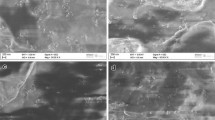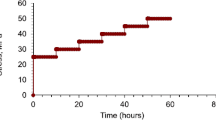Abstract
Stress induced change in intrinsic time scale was investigated by nonlinear creep tests of polypropylene (PP) at room temperature of 27 °C. The time-dependent axial elongations of the specimen were measured at 5 different stress levels, from 10.2 to 20 MPa, and modeled according to the time-stress superposition principle. The test duration was only 1 h. The test results show that the creep compliance vs logarithm time curves at different stresses depart from each other, indicating nonlinear viscoelastic behavior, and can be horizontally shifted to overlap onto a smooth master curve up to 51.5 h at the reference stress of 10.2 MPa. It is demonstrated that the time-stress superposition principle provides an accelerated test technique to evaluate the materials’ long-term mechanical properties.
Similar content being viewed by others
References
FINDLEY W N, LAI J S Y. A modified superposition principle applied to creep of nonlinear viscoelastic material under abrupt change in state of combined stress[J]. Transactions of the Society Rheology, 1967, 11(3): 361–380.
LUO Wen-bo, YANG Ting-qing, AN Qun-li. Time-temperature-stress equivalence and its application to nonlinear viscoelastic materials[J]. Acta Mechanica Solida Sinica, 2000, 14(3): 195–199.
YEN S C, WILLIAMSON F L. Accelerated characterization of creep response of an off-axis composite material[J]. Composites Science and Technology, 1990, 38: 103–118.
BROSTOW W. Time-stress correspondence in viscoelastic materials: An equation for the stress and temperature shift factor[J]. Materials Research Innovations, 2003, 3: 347–351.
LUO Wen-bo, WANG Chu-hong, ZHAO Rong-guo. Application of time-temperature-stress superposition principle to nonlinear creep of poly(methyl methacrylate)[J]. Key Engineering Materials, 2007, 340–341: 1091–1096.
JAZOULI S, LUO Wen-bo, BREMAND F, VU-KHANH T. Application of time-stress equivalence to nonlinear creep of polycarbonate[J]. Polymer Testing, 2005, 24: 463–467.
AKLONIS J J, MACKNIGHT W J. Introduction to Polymer Viscoelasticity[M]. 2nd ed. New York: Wiley-Interscience Publication, 1983.
DEAN G D, TOMLINS P E, READ B E. A model for nonlinear creep and physical aging in poly(vinyl chloride)[J]. Polymer Engineering and Science, 1995, 35(16): 1282–1289.
HUTCHINSON J M. Physical aging of polymers[J]. Progress in Polymer Science, 1995, 20(4): 703–760.
HO C H, VU-KHANH T. Physical aging and time-temperature behavior concerning fracture performance of polycarbonate[J]. Theor Appl Fract Mech, 2004, 41: 103–114.
SULLIVAN J L. Creep and physical aging of composites[J]. Composites Science and Technology 1990, 39(3): 207–232.
STRUIK L C E. Physical Aging in Amorphous Polymers and Other Materials[M]. New York: Elsevier, 1978.
STRUIK L C E. On the rejuvenation of physically aged polymers by mechanical deformation[J]. Polymer, 1997, 38(16): 4053–4057.
MCKENNA G B. Mechanical rejuvenation in polymer glasses: fact or fallacy[J]. Journal of Physics: Condensed Matter, 2003, 15: s737–s763.
KAUSCH H H. Crazing in polymers[S]. Advances in Polymer Science, 91/92, Berlin: Springer-Berlag, 1990.
ESTEVEZ R, TIJSSENS M G A, van der GIESSEN E. Modeling of the competition between shear yielding and crazing in glassy polymers[J]. J Mech Phys Solids, 2000, 48(2): 2585–2617.
LUO Wen-bo, LIU Wen-xian. Incubation time to crazing in stressed poly(methyl methacrylate)[J]. Polymer Testing, 2007, 26(3): 413–418.
LUO Wen-bo, YANG Ting-qing, WANG Xia-yu. Time-dependent craze zone growth at a crack tip in polymer solids[J]. Polymer, 2004, 45(10): 3519–3525.
Author information
Authors and Affiliations
Corresponding author
Additional information
Foundation item: Project(10572123) supported by the National Natural Science Foundation of China; Project(KF0502) supported by the Key Laboratory of Low Dimensional Materials and Application Technology of Xiangtan University, Ministry of Education, China
Rights and permissions
About this article
Cite this article
Luo, Wb., Wang, Ch., Vu-Khanh, T. et al. Time-stress equivalence: Application to nonlinear creep of polypropylene. J Cent. South Univ. Technol. 14 (Suppl 1), 310–313 (2007). https://doi.org/10.1007/s11771-007-0271-1
Published:
Issue Date:
DOI: https://doi.org/10.1007/s11771-007-0271-1




